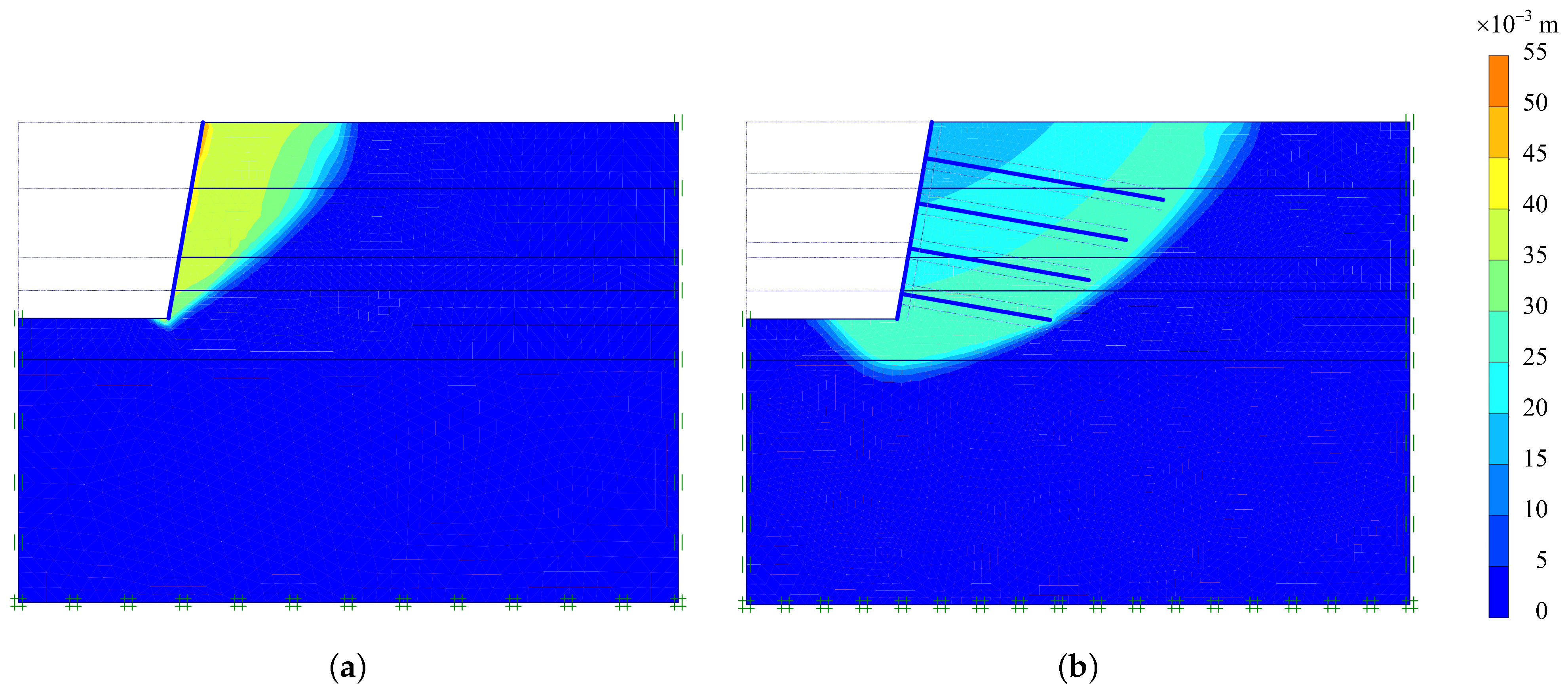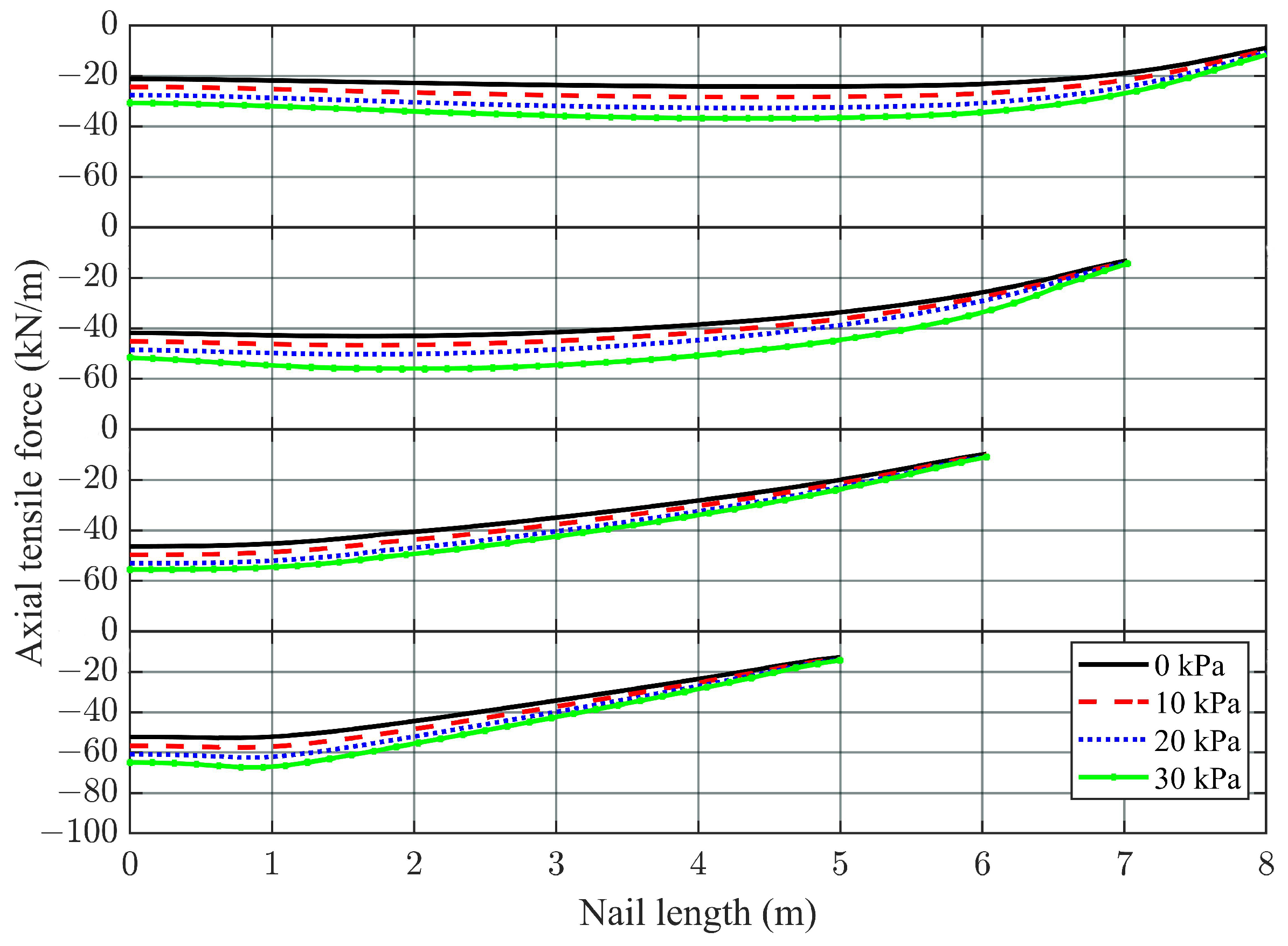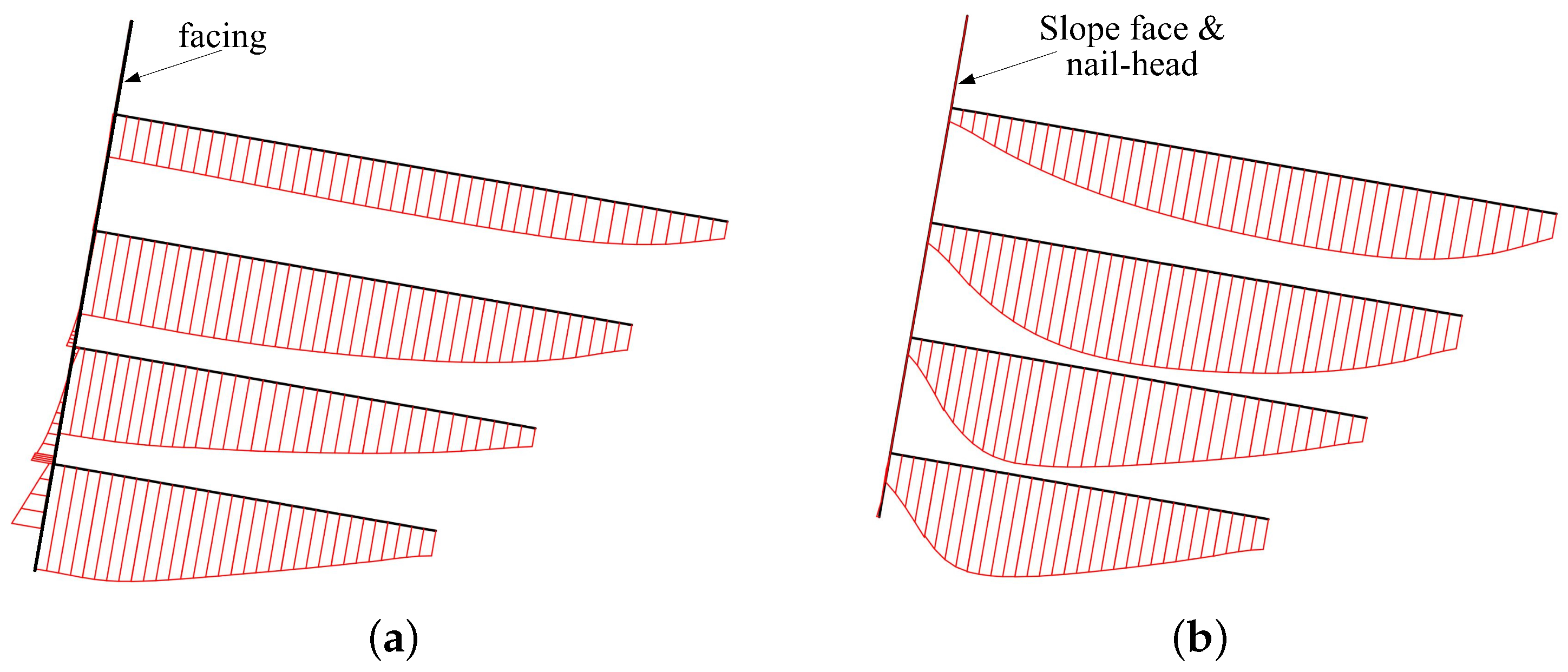Responses of Structural Components of a Full-Scale Nailed Retaining Structure under the Influence of Surcharge Loading and Nail Head Configuration: A Numerical Study
Abstract
1. Introduction
2. Materials and Methods
2.1. Method and Materials Properties
2.2. Axial Stiffness and Flexural Rigidity of Nail and Nail Head
- Stage 1: Excavate to EL −1.70 m, and install the first-level nailing (Nail row–1) at EL −1.20 m and nail head NH01/facing.
- Stage 2: Excavate to EL −3.20 m, and install the second-level nailing (Nail row–2) at EL −2.70 m and nail head NH02/facing.
- Stage 3: Excavate to EL −4.70 m, and install the third-level nailing (Nail row–3) at EL −4.20 m and nail head NH03/facing.
- Stage 4: Excavate to EL −6.53 m, and install the fourth-level nailing (Nail row–4) at EL −5.7 m and nail head NH04/facing.
3. Results and Discussion
3.1. Analysis of Unsupported Excavation Face
3.2. Effect of Facing Thickness
3.3. Effect of Surcharge Loading
3.4. Effect of Soil Nail Head Size
3.5. Effect of Nail Head Thickness
3.6. Surcharge, Maximum Nail Force and Vertical Settlement of Ground Surface
4. Conclusions
- Increasing facing thickness has obvious influence on the facing shear force and bending moment, but it only has a slight or perhaps negligible influence on the facing axial force and soil horizontal displacement.
- Surcharge loading did not seem to have any influence on the facing shear force and bending moment, but as surcharge loading increases, both the facing axial force and soil horizontal displacement increase. The maximum horizontal displacement was found to be mobilized at about 70% of excavated depth. It was observed that the maximum nail axial force increases with the increase of nail embedment depth from top to bottom. The sum of all four nail axial forces acting on the facing also increased with the increase of surcharge loading.
- Nail axial force at the fixed end on the excavated face was found to increase with the increase of nail head size, with the maximum value being observed in the case of full-face facing. Conversely, the horizontal displacement of the retained soil reduces as the nail head size increases with the minimum displacement profile being obtained when the excavated face was protected by a full-face facing. In other words, as the nail head size increases, the overall stability of the retained soil also increases. Although full-face facing provided the highest overall stability, particular attention must be paid to the design of the nail reinforcement such that the mobilized axial force is still within the reinforcement’s tensile capacity.
- Changing nail head thickness has no effect on the nail axial force and the horizontal displacement of the retained soil.
- Vertical settlement of the ground surface, on which the surcharge loading was acting, was found to be linearly related to the maximum nail axial (tensile) force but not the nail embedment depth.
Author Contributions
Funding
Institutional Review Board Statement
Informed Consent Statement
Data Availability Statement
Acknowledgments
Conflicts of Interest
Abbreviations
| FEM | Finite element method |
| FHWA | Federal Highway Administration |
| FOS | Factor of safety |
| LEM | Limit equilibrium method |
| NH | Nail head |
| SRM | Strength reduction method |
References
- GEO. Guide to Soil Nail Design and Construction: Geoguide 7; Geotechnical Engineering Office, The Government of the Hong Kong, Special Administrative Region: Hong Kong, 2008; 100p.
- Mittal, S.; Biswas, A.K. River bank erosion control by soil nailing. Geotech. Geol. Eng. 2006, 24, 1821–1833. [Google Scholar] [CrossRef]
- Plumelle, C.; Schlosser, F. A French National Research Project on Soil Nailing: CLOUTERRE. In Performance of Reinforced Soil Structure: Proceedings of the International Reinforced Soil Conference; British Geotechnical Society: Glassgow, UK, 1990; pp. 219–223. [Google Scholar]
- Schlosser, F.; Plumelle, C.; Unterreiner, P.; Benoît, J. Failure of a full scale experimental soil-nailed wall by reducing the nails lengths (French Research Project CLOUTERRE). Proc. Int. Conf. Earth Reinf. Pract. 1992, 1, 531–535. [Google Scholar]
- Smith, I.M.; Su, N. Three-dimensional FE analysis of a nailed soil wall curved in plan. Int. J. Numer. Anal. Methods Geomech. 1997, 21, 583–597. [Google Scholar] [CrossRef]
- Turner, J.P.; Jensen, W.G. Landslide stabilization using soil nail and mechanically stabilized earth walls: Case study. J. Geotech. Geoenviron. Eng. 2005, 131, 141–150. [Google Scholar] [CrossRef]
- Li, J.; Tham, L.G.; Junaideen, S.M.; Yue, Z.Q.; Lee, C.F. Loose fill slope stabilization with soil nails: Full-scale test. J. Geotech. Geoenviron. Eng. 2008, 134, 277–288. [Google Scholar] [CrossRef]
- Duncan, J.M. State of the art: Limit equilibrium and finite element analysis of slopes. J. Geotech. Eng. 1996, 122, 577–596. [Google Scholar] [CrossRef]
- Gui, M.W.; Ng, C.W.W. Numerical study of nailed slope excavation. Geotech. Eng. J. Seags Agssea 2006, 37, 1–12. Available online: http://seags.ait.asia/e-journal/1970-2012/GEJ_2006_v37n1_April.pdf (accessed on 22 February 2022).
- Rawat, S.; Gupta, A.K.; Kumar, A. Pullout of soil nail with circular discs: A three-dimensional finite element analysis. J. Rock Mech. Geotech. Eng. 2017, 9, 967–980. [Google Scholar] [CrossRef]
- Zhou, W.H.; Yuen, K.V.; Tan, F. Estimation of maximum pullout shear stress of grouted soil nails using Bayesian probabilistic approach. Int. J. Geomech. 2013, 13, 659–664. [Google Scholar] [CrossRef]
- Wong, I.H.; Low, B.K.; Pang, P.Y.; Raju, G.V.R. Field performance of nailed soil wall in residual soil. J. Perform. Constr. Facil. 1997, 11, 105–112. [Google Scholar] [CrossRef]
- Zhang, M.J.; Song, E.X.; Chen, Z.Y. Ground movement analysis of soil nailing construction by three-dimensional (3-D) finite element modeling (FEM). Comput. Geotech. 1999, 25, 191–204. [Google Scholar] [CrossRef]
- Fan, C.C.; Luo, J.H. Numerical study on the optimum layout of soil–nailed slopes. Comput. Geotech. 2008, 35, 585–599. [Google Scholar] [CrossRef]
- Mohamed, M.H.; Ahmed, M.; Mallick, J.; Hoa, P.V. An experimental study of a nailed soil slope: Effects of surcharge loading and nails characteristics. Appl. Sci. 2021, 11, 4842. [Google Scholar] [CrossRef]
- Ghareh, S. Parametric assessment of soil-nailing retaining structures in cohesive and cohesionless soils. Measurement 2015, 73, 341–351. [Google Scholar] [CrossRef]
- Rawat, S.; Gupta, A.K. Analysis of a nailed soil slope using limit equilibrium and finite element methods. Int. J. Geosynth. Ground Eng. 2016, 2, 34. [Google Scholar] [CrossRef]
- Wei, W.B.; Cheng, Y.M. Soil nailed slope by strength reduction and limit equilibrium methods. Comput. Geotech. 2010, 37, 602–618. [Google Scholar] [CrossRef]
- Dai, Z.H.; Gup, W.D.; Zheng, G.X.; Ou, Y.; Chen, Y.J. Moso bamboo soil-nailed wall and its 3D nonlinear numerical analysis. Int. J. Geomech. 2016, 16, 04016012. [Google Scholar] [CrossRef]
- Mohamed, M.H.; Ahmed, M.; Mallick, J. Pullout behavior of nail reinforcement in nailed soil. Appl. Sci. 2021, 11, 6419. [Google Scholar] [CrossRef]
- Rotte, V.M.; Viswanadham, B.V.S. Influence of nail inclination and facing material type on soil-nailed slopes. Proc. Inst. Civ. Eng. Ground Improv. 2013, 166, 86–107. [Google Scholar] [CrossRef]
- Viswanadham, B.V.S.; Rotte, V.M. Effect of facing type on the behaviour of soil-nailed slopes: Centrifuge and numerical study. Discovery 2015, 46, 214–223. [Google Scholar]
- Joshi, B. Behavior of calculated nail head strength in soil-nailed structures. J. Geotech. Geoenviron. Eng. 2003, 129, 819–828. [Google Scholar] [CrossRef]
- Kaothon, P.; Chhun, K.T.; Yune, C.Y. Numerical evaluation on steep soil-nailed slope using finite element method. Int. J. Geo-Eng. 2021, 12, 299–309. [Google Scholar] [CrossRef]
- Pun, W.K.; Shiu, Y.K. Design practice and technical developments of soil nailing in Hong Kong. In Geotechnical Advancements in Hong Kong Since 1970s: Proceedings of the HKIE Geotechnical Division 27th Annual Seminar; Hong Kong Institution of Engineers, Geotechnical Division: Hong Kong, 2007; Volume 197, p. 212. Available online: https://hkss.cedd.gov.hk/hkss/filemanager/common/publications-resources/list-of-technical-papers/220_Pun%20&%20Shiu%20(2007)_Design%20practice%20and%20technical%20developments%20of%20soil%20nailing%20in%20Hong%20Kong.pdf (accessed on 22 February 2022).
- Johari, A.; Hajivand, A.K.; Binesh, S.M. System reliability analysis of soil nail wall using random finite element method. Bull. Eng. Geol. Environ. 2020, 79, 2777–2798. [Google Scholar] [CrossRef]
- Wang, H.; Cheng, J.; Li, H.; Dun, Z.; Cheng, B. Full-scale field test on construction mechanical behaviors of retaining structure enhanced with soil nails and prestressed anchors. Appl. Sci. 2021, 11, 7928. [Google Scholar] [CrossRef]
- Briaud, J.L.; Lim, Y.J. Soil-nailed wall under piled bridge abutment: Simulation and guidelines. J. Geotech. Geoenviron. Eng. 1997, 123, 1043–1050. [Google Scholar] [CrossRef]
- Sivakumar Babu, G.L.; Singh, V.P. Simulation of soil nail structures using PLAXIS 2D. Plaxis Bull. 2009, 25, 16–21. Available online: https://communities.bentley.com/cfs-file/__key/communityserver-wikis-components-files/00-00-00-01-05/Iss25_5F00_Art3_5F002D005F00_Simulation_5F00_of_5F00_Nail_5F00_Structures.pdf (accessed on 22 February 2022).
- Singh, V.P.; Sivakumar Babu, G.L. 2D numerical simulations of soil nail walls. Geotech. Geol. Eng. 2010, 28, 299–309. [Google Scholar] [CrossRef]
- Plaxis 2D—Version 8: Reference Manual; Delft University of Technology: Delft, The Netherlands, 2002.
- Garzón-Roca, J.; Capa, V.; Torrijo, F.J.; Company, J. Designing soil-nailed walls using the Amherst wall considering problematic issues during execution and service life. Int. J. Geomech. 2019, 19, 05019006. [Google Scholar] [CrossRef]
- Lazarte, C.A.; Robinson, H.; Gomez, J.E.; Baxter, A.; Cadden, A.; Berg, R. Geotechnical Enginering Circular No 7: Soil Nail Walls, Reference Manual. Publication No. FHWA-NHI-14-007. U.S. Department of Transportation Federal Highway Administration. 2015. Available online: https://www.geoengineer.org/publications/online-library?keywords%5B0%5D=Geotechnical%20Enginering%20Circular%20No%207%3A%20Soil%20Nail%20Walls%2C%20Reference%20Manual (accessed on 20 February 2022).
- Taylor, T.P.; Collin, J.G.; Berg, R.R. Evaluation of Limit Equilibrium Analysis Methods for Design of Soil Nail Walls; Report No. FHWA-NHI-17-068; Federal Highway Administration: Washington, DC, USA, 2017; 56p. Available online: https://www.fhwa.dot.gov/engineering/geotech/pubs/nhi17068.pdf (accessed on 20 August 2022).
- Al-Hussaini, M.M.; Johnson, L.D. Numerical analysis of reinforced earth wall. Proc. ASCE Symp. Earth Reinf. Pittsburgh 1978, 98–126. [Google Scholar]
- Jaky, J. The coefficient of earth pressure at rest. In Hungarian (A nyugalmi nyomas tenyezoje). J. Soc. Hung. Eng. Arch. 1944, 78, 355–358. [Google Scholar]
- Rowe, R.K.; Ho, S.K. Horizontal deformation in reinforced soil walls. Can. Geotech. J. 1998, 35, 312–327. [Google Scholar] [CrossRef]
- Vieira, C.S.; Lopes, M.L.; Caldeira, L.M.M.S. Influence of facing panel rigidity on performance of reinforced soil retaining walls: A numerical study. In Proceedings of the 4th European Geosynthetics Conference—EuroGeo4, Edinburgh, UK, 7–10 September 2008; p. 244. [Google Scholar]
- Shiu, Y.K.; Chang, G.W.K. Soil Nail Head Review. Geo-Report No. 175. 2005; 106p. Available online: https://www.cedd.gov.hk/eng/publications/geo/geo-reports/geo_rpt175/index.html (accessed on 22 February 2022).
- Rawat, S.; Zodinpuii, R.; Manna, B.; Sharma, K.G. Investigation on failure mechanism of nailed soil slopes under surcharge loading: Testing and analysis. Geomech. Geoengin. 2014, 9, 18–35. [Google Scholar] [CrossRef]














| Soil Layer No. | Soil Types | Thickness (m) | Unit Weight (kN/m3) | Apparent Cohesion (kPa) | Internal Friction Angle (°) | Young’s Modulus (kPa) |
|---|---|---|---|---|---|---|
| 1 | Silt | 2.2 | 18.1 | 14 | 20 | 7000 |
| 2 | Silty clay | 2.3 | 17.9 | 20 | 15 | 12,000 |
| 3 | Silt | 1.1 | 18.2 | 15 | 21 | 7000 |
| 4 | Silty clay | 2.3 | 18.2 | 21 | 16 | 14,000 |
| 5 | Firm clay | 8.1 | 19.0 | 21 | 16 | 26,000 |
| Parameter | Value |
|---|---|
| Yield strength of reinforcement (MPa) | 415 |
| Elastic modulus of reinforcement (GPa) | 200 |
| Elastic modulus of concrete nail head E (GPa) | 34.5 |
| Elastic modulus of grout (GPa) | 22 |
| Diameter of reinforcement d (mm) | 20 |
| Length of nails (m) | 5, 6, 7, 8 |
| Inclination of nail (degree) | 10 |
| Horizontal and vertical spacings of nail (m) | 1.5 |
| Thickness of facing t (mm) | 80, 125, 200, 300 |
| Size of the 100 mm thick nail head (m) | 0.2, 0.4 and 0.8 |
| Coefficient of interface |
Disclaimer/Publisher’s Note: The statements, opinions and data contained in all publications are solely those of the individual author(s) and contributor(s) and not of MDPI and/or the editor(s). MDPI and/or the editor(s) disclaim responsibility for any injury to people or property resulting from any ideas, methods, instructions or products referred to in the content. |
© 2023 by the authors. Licensee MDPI, Basel, Switzerland. This article is an open access article distributed under the terms and conditions of the Creative Commons Attribution (CC BY) license (https://creativecommons.org/licenses/by/4.0/).
Share and Cite
Gui, M.-W.; Rajak, R.P. Responses of Structural Components of a Full-Scale Nailed Retaining Structure under the Influence of Surcharge Loading and Nail Head Configuration: A Numerical Study. Buildings 2023, 13, 561. https://doi.org/10.3390/buildings13020561
Gui M-W, Rajak RP. Responses of Structural Components of a Full-Scale Nailed Retaining Structure under the Influence of Surcharge Loading and Nail Head Configuration: A Numerical Study. Buildings. 2023; 13(2):561. https://doi.org/10.3390/buildings13020561
Chicago/Turabian StyleGui, Meen-Wah, and Ravendra P. Rajak. 2023. "Responses of Structural Components of a Full-Scale Nailed Retaining Structure under the Influence of Surcharge Loading and Nail Head Configuration: A Numerical Study" Buildings 13, no. 2: 561. https://doi.org/10.3390/buildings13020561
APA StyleGui, M.-W., & Rajak, R. P. (2023). Responses of Structural Components of a Full-Scale Nailed Retaining Structure under the Influence of Surcharge Loading and Nail Head Configuration: A Numerical Study. Buildings, 13(2), 561. https://doi.org/10.3390/buildings13020561







